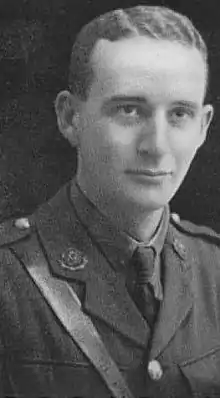Basil Horsfall
Second Lieutenant Basil Arthur Horsfall, VC (4 October 1887 – 27 March 1918) was a British-Ceylonese recipient of the Victoria Cross, the highest and most prestigious award for gallantry in the face of the enemy that can be awarded to British and Commonwealth forces.
Basil Arthur Horsfall | |
|---|---|
 Lt. Basil Arthur Horsfall VC | |
| Born | 4 October 1887 Colombo, Ceylon |
| Died | 21 March 1918 (aged 30) Between Moyenneville and Ablainzevelle, France |
| Allegiance | |
| Service/ | |
| Years of service | 1917 - 1918 |
| Rank | Second Lieutenant |
| Unit | Ceylon Engineer Volunteers East Lancashire Regiment |
| Battles/wars | World War I † |
| Awards | |
Early life
Born on 4 October 1887 in Colombo, Ceylon (now Sri Lanka), Horsfall was educated at S. Thomas' College, Mount Lavinia in Ceylon[1] and at Sir William Borlase's Grammar School,[2] Marlow in England. He left a position with Barclay's Bank, London, to become a rubber planter back in Ceylon, where he also held a civil service position with the Public Works Department and served with the Ceylon Engineer Volunteers. During World War I, he returned to Britain in July 1916 to enlist in the British Army and was commissioned as a 2nd Lieutenant in the East Lancashire Regiment in December. He was wounded at Rouex on 11 May 1917 while serving with the 1st Battalion. After recovering from his wound he joined the 11th Battalion, (the Accrington Pals), in the Autumn of 1917.[3]
Details
Horsfall was 30 years old, and a second lieutenant in the 11th Battalion, East Lancashire Regiment, during World War I when the following deed took place for which he was awarded the VC.
21 March 1918 (World War I). Between Moyenneville and Ablainzevelle, France, when the enemy attacked Second Lieutenant Horsfall's centre platoon, his three forward sections were driven back and he was wounded in the head by enemy fire. Ignoring the wound, he immediately reorganised what remained of his troops and counterattacked to regain his original position. Despite the severity of his head wound, he refused to go to the dressing station, as the three other officers in his company had been killed. Later, he made another counterattack, but was ordered to withdraw. The last to leave his position, he was shot soon afterwards.[4][5]
Distinctions and tributes
_ribbon.png.webp) Victoria Cross. Horsfall's medal is kept in the Queen's Lancashire Regiment Museum at Fulwood Barracks, Preston, Lancashire.
Victoria Cross. Horsfall's medal is kept in the Queen's Lancashire Regiment Museum at Fulwood Barracks, Preston, Lancashire.- Horsfall's name is on the Arras Memorial in France. It is not known where he is buried.[6]
- The school of Ablainzevelle was named after Horsfall in 2019.[7]
There is a blue plaque commemorating Horsfall on the front wall of Borlase School in Marlow. His name is recorded on the war memorial inside the school chapel and a replica of his VC is placed inside the chapel.
Notes
- Well done S. Thomas’ Esto perpetua, By T. D. S. A. Dissanayaka
- Dowager Duchess of Devonshire visits childhood home
- Jackson, pp. 167–8.
- "No. 30697". The London Gazette (Supplement). 21 May 1918. p. 6058.
- Jackson, pp. 173–4.
- CWGC entry
- "Ablainzevelle - L'école porte désormais le nom du lieutenant Basil Arthur Horsfall". La Voix du Nord (in French). Retrieved 6 April 2019.
References
- Andrew Jackson, Accrington's Pals: The Full Story, Barnsley, Pen & Sword, 2013, ISBN 9781-84884-469-8.
- Monuments to Courage (David Harvey, 1999)
- The Register of the Victoria Cross (This England, 1997)
- VCs of the First World War - Spring Offensive 1918 (Gerald Gliddon, 1997)